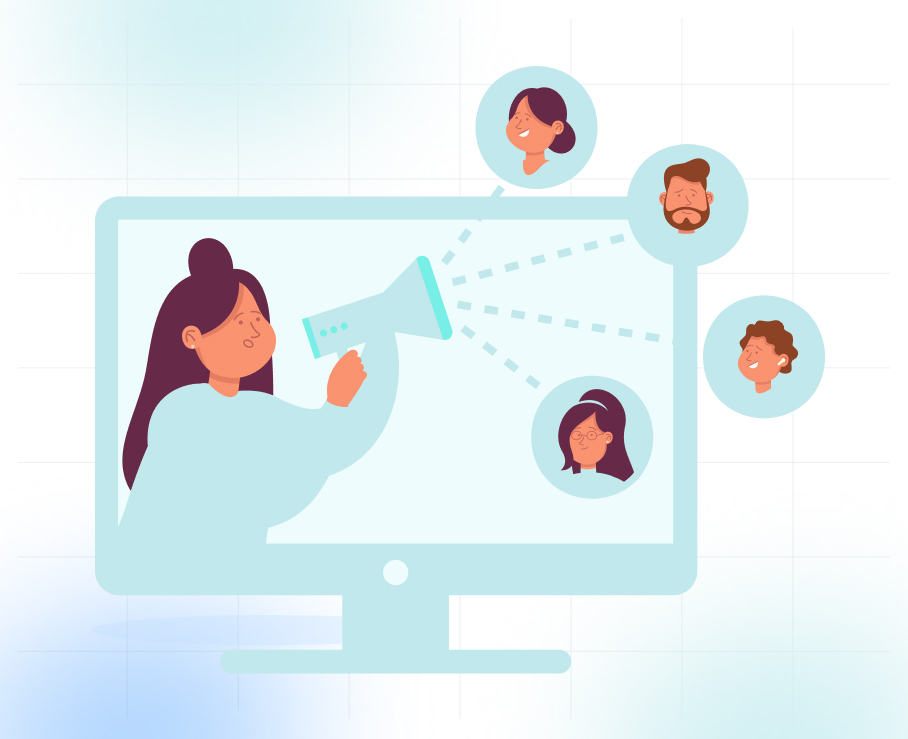
Recruitment Lead Generation Made Easy: 8 Strategies for Agencies
.jpg)
Is your staffing agency struggling to connect with businesses seeking skilled talent? We know how frustrating it can be to constantly face the challenge of sourcing the right candidates while competing for the attention of decision-makers.
With nearly 71% of employers struggling to find qualified talent, up from just 40% a decade ago, it’s clear that the need for skilled professionals has never been greater. But despite this growing demand, many recruitment agencies still struggle to engage the right clients at the right time.
That’s where adopting a modern, data-driven recruitment lead generation strategy can help. It enables your agency to connect with businesses precisely when they're ready to engage, thereby boosting both efficiency and success.
In this blog, we’ll walk you through proven lead-generation strategies, share best practices to help you optimize your efforts, and discuss how outsourcing can be a game-changer for your agency. Let’s explore how you can leverage these strategies to turn today’s challenges into tomorrow’s opportunities.
TL;DR:
- Recruitment lead generation is essential for staffing agencies to connect with the right businesses at the right time.
- Traditional methods are outdated; modern, data-driven strategies are needed for success.
- Key strategies include defining your target audience, setting measurable objectives, and selecting the appropriate tools.
- Outsourcing lead generation can help you focus on core activities while ensuring a steady flow of high-quality leads.
- Focus on metrics like conversion rates and lead value to measure success and refine your approach.
What is Recruitment Lead Generation?
Recruitment lead generation involves identifying and engaging decision-makers within companies that are actively seeking or passively considering hiring talent. It generates a steady stream of qualified leads interested in your recruitment services and converts initial interest into tangible placement opportunities.
By focusing on lead generation, you ensure your agency has a steady stream of potential clients, streamlining your process of connecting with businesses in need of skilled candidates.
Let’s discuss why recruitment lead generation is essential for your business.
Why Does Your Business Need Recruitment Lead Generation?
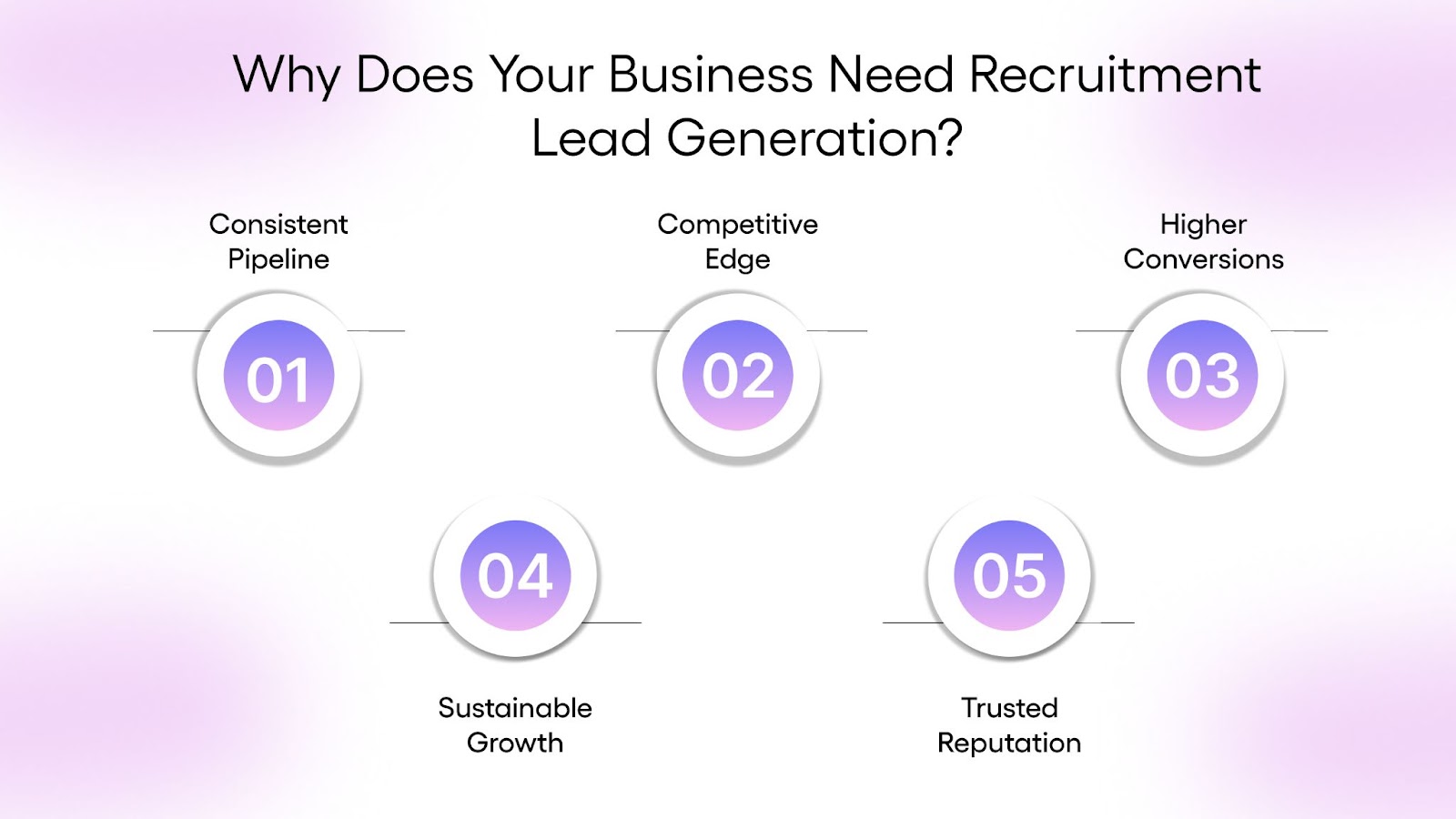
Effective recruitment lead generation is central to your strategy because it ensures a steady flow of opportunities, helps you reach decision-makers before competitors, boosts conversions with targeted prospects, and supports business growth with a diversified client base. Let’s take a look at all the benefits in detail:
- Steady Flow of Opportunities: A solid lead generation strategy ensures your team never struggles to find their next client or job brief.
- Stay Ahead of Competitors: By reaching out to decision-makers at the right time, you’re already in front of your competitors, increasing your visibility.
- Higher Conversions: Targeted lead generation helps attract businesses that truly need your services, leading to quicker and more valuable conversions.
- Business Growth and Stability: A constant influx of quality leads results in a diversified client base, reduces risk, and sets the foundation for long-term growth.
- Enhanced Agency Credibility: Consistent outreach and specialized email communication build your agency’s credibility, showing that you understand your market and its needs.
With recruitment lead generation, your agency can stay ahead of the curve by creating lasting relationships with clients fulfilling their requests with top-tier candidates. But how do you do that? To answer this question, it’s important first to uncover the four pillars of lead generation. Let’s explore them in the next section.
Understanding The Four Ls of Lead Generation
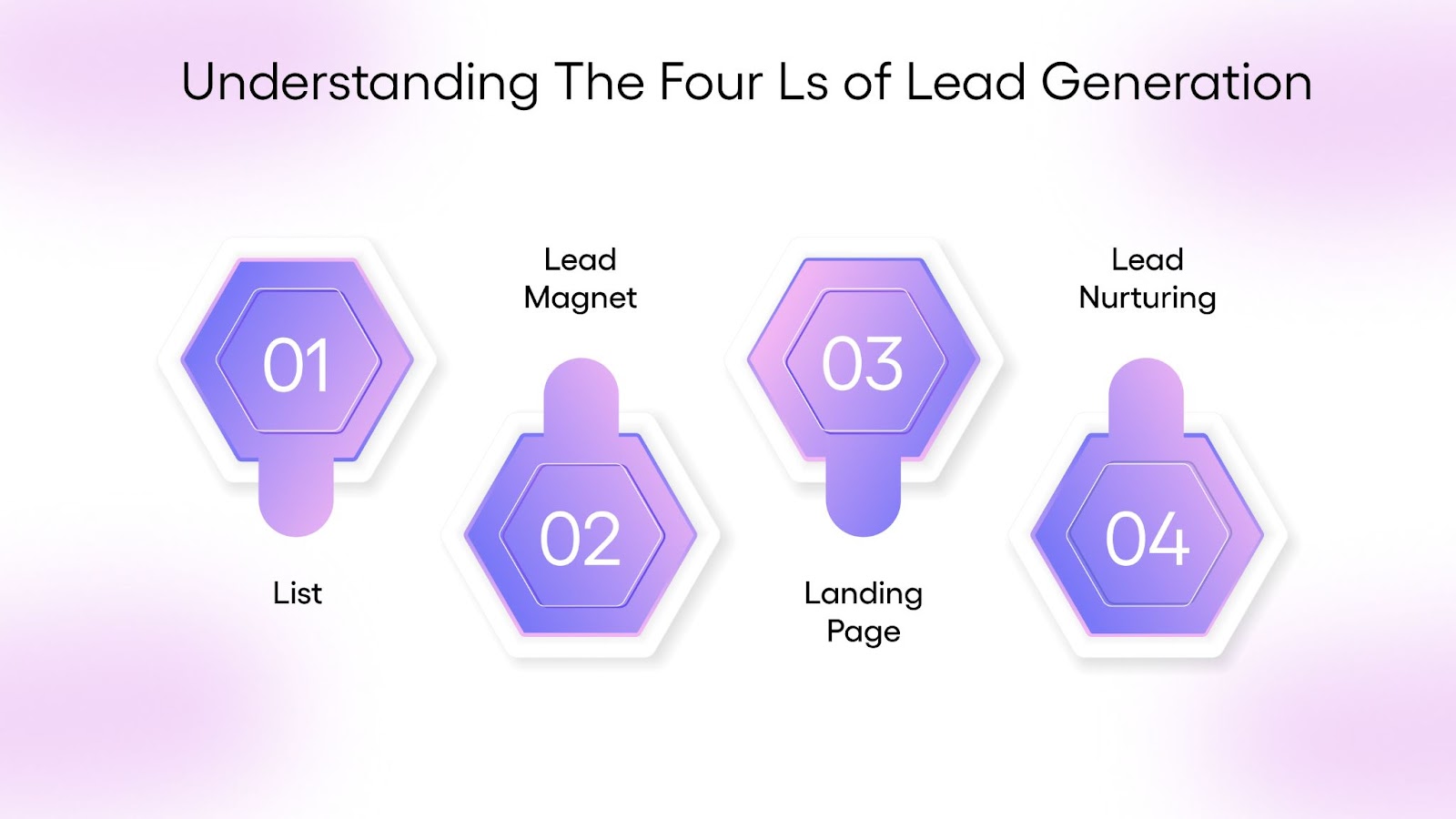
We understand how overwhelming it can be to juggle multiple lead-generation strategies while trying to connect with the right clients and candidates. That's why we focus on the four essential components that make up a winning lead generation strategy, helping you drive more qualified leads efficiently.
Here’s how the Four L’s of Lead Generation can guide your efforts:
- List: Identify and build a highly-targeted list of prospects. Focus on businesses or individuals that fit your Ideal Customer Profile (ICP). Tailor your outreach to those who will benefit most from your services.
- Lead Magnet: Create valuable content that attracts and engages your target audience. Examples include industry-specific reports, job-seeker guides, or whitepapers. This entices potential clients to take action.
- Landing Page: Develop a high-converting landing page that resonates with prospects. Ensure it offers a clear value proposition and a simple call-to-action (CTA), like scheduling a meeting or downloading your lead magnet.
- Lead Nurturing: Maintain ongoing connections with leads through targeted email marketing, follow-up communications, and personalized outreach. Nurturing helps build trust and ensures you remain top of mind when they’re ready to act.
Implementing these four components into your recruitment lead generation strategy helps streamline your process, increase conversions, and grow your business. Now you understand the core of lead generation, but to succeed in specific recruitment lead generation, you need an effective plan of action. Let’s discuss those strategies in the next section.
Also read: Guide to MSP Lead Generation & Appointment Setting: Tips and Tricks
How To Craft a Winning Recruitment Lead Generation Strategy?
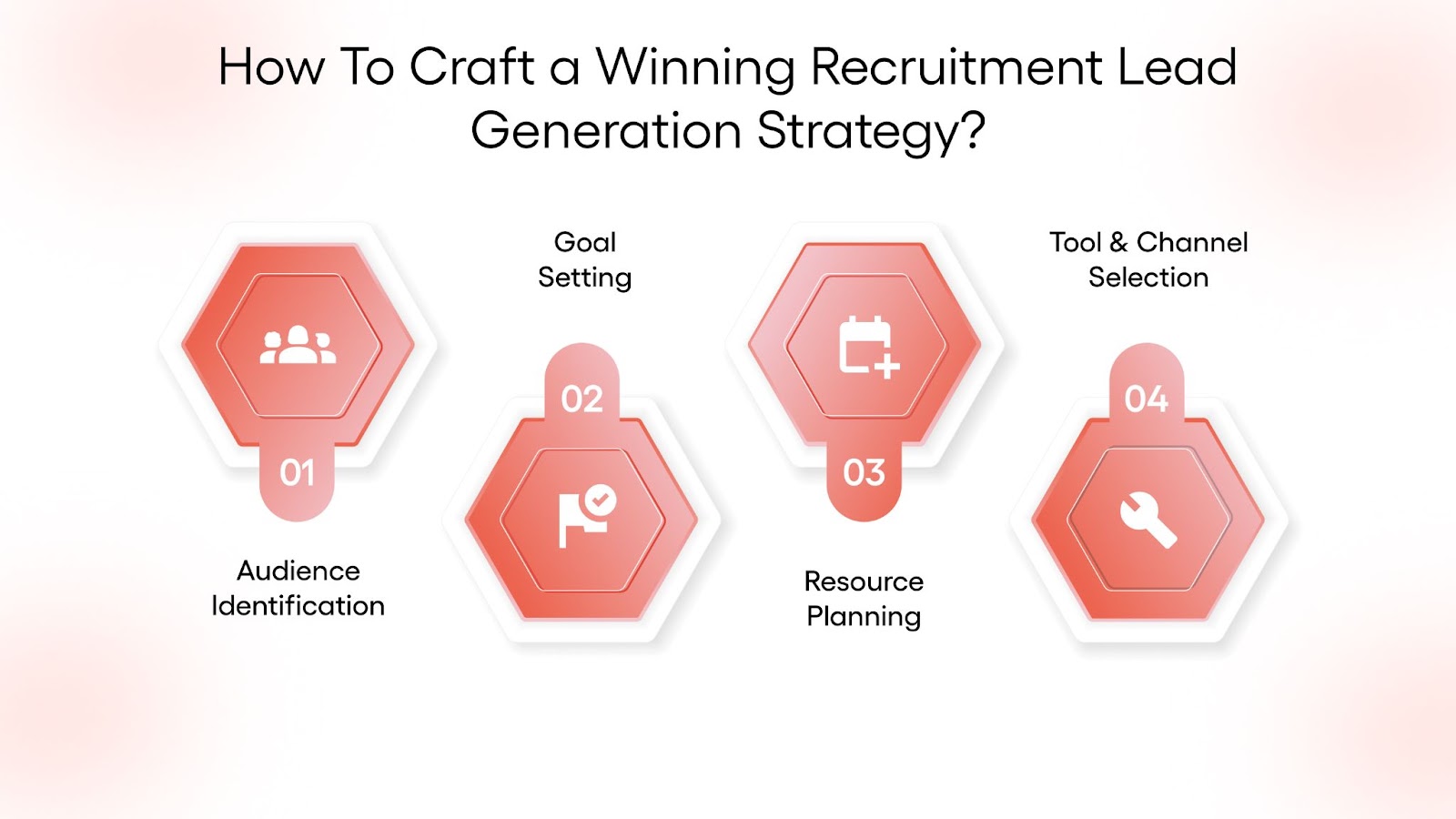
A winning recruitment lead generation strategy is vital to the success of your staffing agency. It’s about understanding the nuances of your target market and aligning your lead-generation efforts with your specific goals.
A strategic approach ensures that your efforts are focused on attracting high-quality leads, engaging them at the right time, and nurturing long-term relationships. In this section, we’ll break down the essential components of a recruitment lead generation strategy that works. Let's look into the steps that will help you create a lead generation strategy that delivers.
Step 1: Define Your Target Audience
Defining your target audience ensures that your recruitment efforts are focused and efficient. It helps identify businesses actively seeking staffing solutions, allowing you to concentrate on high-value leads that align with your expertise.
Here’s how to define your target audience for effective lead generation:
- Identify Industry Needs: Focus on industries with ongoing recruitment demand. For example, IT, healthcare, and manufacturing often require continuous talent sourcing.
- Company Size Matters: Tailor your strategy to business size. Small businesses might need full-time employees, while larger companies could be more interested in temporary or contract staff.
- Specialization in Job Roles: Determine which job positions you’re equipped to fill, whether it's tech roles, executive positions, or entry-level labor.
- Location Targeting: Narrow your focus by geography, are you providing services regionally or nationally? This helps in customizing your outreach.
- Understand Client Pain Points: Research the challenges companies face in hiring, such as skill shortages or slow recruitment processes, and position your agency as the solution to these issues.
Targeting the right audience ensures you reach the companies in need, increasing the efficiency of your lead-generation efforts.
Step 2: Set Clear and Measurable Goals
Setting clear, measurable goals is essential for creating a focused and effective recruitment lead generation strategy. Without well-defined objectives, your efforts may become unfocused, making it more difficult to measure success and optimize your approach.
Here’s how to set actionable and measurable goals:
- Align Goals with Business Objectives: Start by identifying what your staffing agency wants to achieve, whether it's growing MRR, filling a certain number of positions, or expanding into new markets. Align these goals with your business priorities.
- Use SMART Goals: Ensure your goals are Specific, Measurable, Achievable, Relevant, and Time-bound. For instance, the target is to generate 50 qualified leads within the next quarter or secure five new client contracts.
- Focus on Lead Quality, Not Just Quantity: Instead of simply aiming for a high number of leads, focus on targeting high-value prospects who fit your ideal client profile. This leads to higher conversion rates and more impactful results.
- Set Milestones: Break down your long-term goals into smaller, more manageable milestones. This helps you stay on track and allows for regular assessment of progress.
By defining clear goals, your agency can measure progress, stay focused, and fine-tune strategies as you move forward.
Read: Ultimate Lead Qualification Checklist: Convert More Sales in 2025
Step 3: Determine Your Budget and Resources
Determining your budget and resources is a critical first step in building an effective recruitment lead-generation strategy. Without a clear understanding of your financial and operational capacity, you may end up spreading yourself too thin or under-resourcing important areas of your campaign.
Here’s how to determine your budget and resources:
- Assess Available Financial Resources: Clearly define how much of your budget can be allocated to lead generation. A targeted email outreach campaign or LinkedIn prospecting can be cost-effective, but paid advertising can increase the overall cost.
- Evaluate Team Capacity: Start by taking a hard look at your internal bandwidth. Does your team have the resources, time, and focus to drive lead generation at scale consistently? If the answer is no, it’s not a weakness—it’s a signal to bring in the right support. That’s where we come in.
At TLM, we specialize in delivering high-quality Sales Qualified Leads (SQLs) and managing appointment booking, so your team can concentrate on what they do best: closing deals and driving revenue. We don’t just fill your pipeline, we build momentum.
- Plan for Long-Term Sustainability: Lead generation requires consistent effort. Allocate a budget for ongoing campaigns and ensure that resources are available to maintain a full pipeline, particularly for continuous outreach and nurturing efforts.
Knowing where to allocate your budget ensures your recruitment lead-generation efforts are well-funded, measurable, and sustainable.
Step 4: Choose the Right Lead Generation Tools and Channels
When selecting lead generation tools and channels for your staffing and recruitment business, it's important to align with your specific audience and business objectives. The right tools and channels will not only increase the quality of your leads but also help streamline your recruitment process, making it more efficient and scalable. Let’s take a look at the most effective channels and tools you can use to attract top candidates for your clients.
Selecting the Right Tools for Recruitment Lead Generation
- Email Marketing Tools: Opt for tools designed specifically for recruitment lead generation. These tools should help you design targeted campaigns, automate outreach, and track performance efficiently. Look for features like A/B testing, personalized email templates, and integration with lead capture forms.
- Lead Scoring and Tracking Tools: Select tools that help you score leads based on engagement levels. This will allow your team to focus efforts on the most promising candidates.
- Analytics and Reporting Tools: Utilize tools that offer in-depth campaign analytics, allowing you to refine your strategies over time.
Choosing the Right Lead Generation Channels
Each of these channels has its place in a well-rounded lead generation strategy. However, knowing their limitations will allow you to focus on the most effective approach
Also read: The Best Time to Send Marketing Emails in 2025
Step 5: Create Compelling Messaging That Resonates
Effective messaging speaks directly to your target audience’s needs. This means crafting messages that resonate with hiring managers and decision-makers. A well-crafted message can spark interest and drive action.
Here’s how to create messaging that gets results:
- Personalize Your Emails: Address specific pain points. Example: “Struggling to find qualified IT candidates?” A personalized message immediately grabs attention.
- Highlight Benefits Over Features: Focus on how you solve problems. Example: “We provide pre-screened candidates who are ready to hit the ground running, saving you time.”
- Use Clear Calls-to-Action (CTAs): Be direct with the next steps. Example: “Schedule a call today to discuss your hiring needs.”
- Keep it Short and Direct: Decision-makers are busy. Get straight to the point with concise, relevant information that speaks to their needs.
- Share Success Stories: Briefly mention past wins that relate to their industry. Example: “We helped a similar firm hire 15 engineers in under a month.”
Crafting compelling messaging ensures your emails stand out, generate interest, and drive conversions.
Step 6: Build Multi-Channel Campaigns for Maximum Reach
A multi-channel approach ensures you’re reaching your audience where they are. By combining different channels, you amplify your message, engage more prospects, and drive better results.
Here’s how to build effective multi-channel campaigns:
- Combine Email with LinkedIn Outreach: Use email to introduce your services and follow up on LinkedIn to establish credibility and trust. For example, send a personalized email about a candidate and then follow up with them on LinkedIn to discuss your offering.
- Integrate Paid Ads with Organic Social Media: Utilize paid ads to target specific companies while creating organic social content to foster ongoing relationships.
- Leverage SEO with Content Marketing: Optimize your website for search to attract organic traffic and supplement with blog posts that address industry challenges.
- Run Retargeting Ads: Retarget prospects who clicked on your email but didn’t respond. Example: Show them ads for relevant job opportunities or services they engaged with.
By engaging prospects through multiple touchpoints, you stay top of mind and increase the chances of converting them into clients or candidates.
Step 7: Implement Lead Scoring and Prioritization
Effective lead scoring and prioritization enable your team to focus on the most promising prospects, ensuring that time and resources are allocated to leads that are most likely to convert.
Here’s how to implement lead scoring and prioritization:
- Assign Points Based on Engagement: Track actions like email opens, website visits, or social media interactions. For example, assign more points to a prospect who opens multiple emails or downloads your case studies.
- Qualify Based on Firmographics: Score leads based on company size, industry, or location that fit your ideal target market. For example, a large recruitment agency in a high-demand industry would score higher than a smaller, less relevant lead.
- Use Behavioral Triggers: Monitor actions like requests for a demo or a consultation. These are strong indicators of interest. For example, a lead who schedules an appointment or engages in live chat is closer to conversion.
- Prioritize High-Intent Leads: Focus on leads that show signs of urgency, such as those inquiring about immediate job vacancies or sending prompt inquiries. These leads are more likely to make decisions fast.
- Refine Scoring Over Time: Regularly analyze the scoring system to adjust based on the leads that convert. Use past campaign performance to tweak how points are allocated.
With lead scoring, you can streamline your recruitment efforts, saving time and focusing on leads most likely to drive revenue. TLM (The Lead Market) takes this a step further with services like appointment scheduling, targeted campaigning, and demand generation, all designed to help you track and manage leads in real-time.
Our intuitive dashboard enables you to prioritize leads based on their engagement, ensuring that your team focuses on prospects who are truly ready to move forward. Schedule a call to learn more about us.
Step 8: Test, Analyze, and Adjust Campaign Performance
To achieve maximum results from your recruitment lead generation campaigns, it's essential to assess and refine your approach continually. Here's how you can make sure you're always improving:
- Implement A/B Testing: Test different messaging, subject lines, and calls-to-action (CTAs) to determine what resonates most effectively with your prospects. This helps refine your approach over time.
- Analyze Lead Behavior: Assess how leads are engaging with your content and at what stage they drop off. Identifying patterns in lead behavior will allow you to adjust your approach to better engage with them.
- Refine Your Strategy: Use the collected data to make informed decisions about what’s working and what needs to change. Don't be afraid to tweak your messaging, tools, or targeting to improve lead quality.
After implementing your lead generation strategies and putting the right tools into place, it's time to evaluate the effectiveness of your efforts. Understanding the impact of your outreach campaigns is crucial for continuous improvement.
By tracking key metrics, you can measure the success of your efforts and identify areas for optimization. Let's dive into the essential performance metrics that will help you stay on track and ensure your campaigns deliver real, measurable results.
Key Metrics to Track For Analyzing the Success of Your Recruitment Lead Generation Campaigns
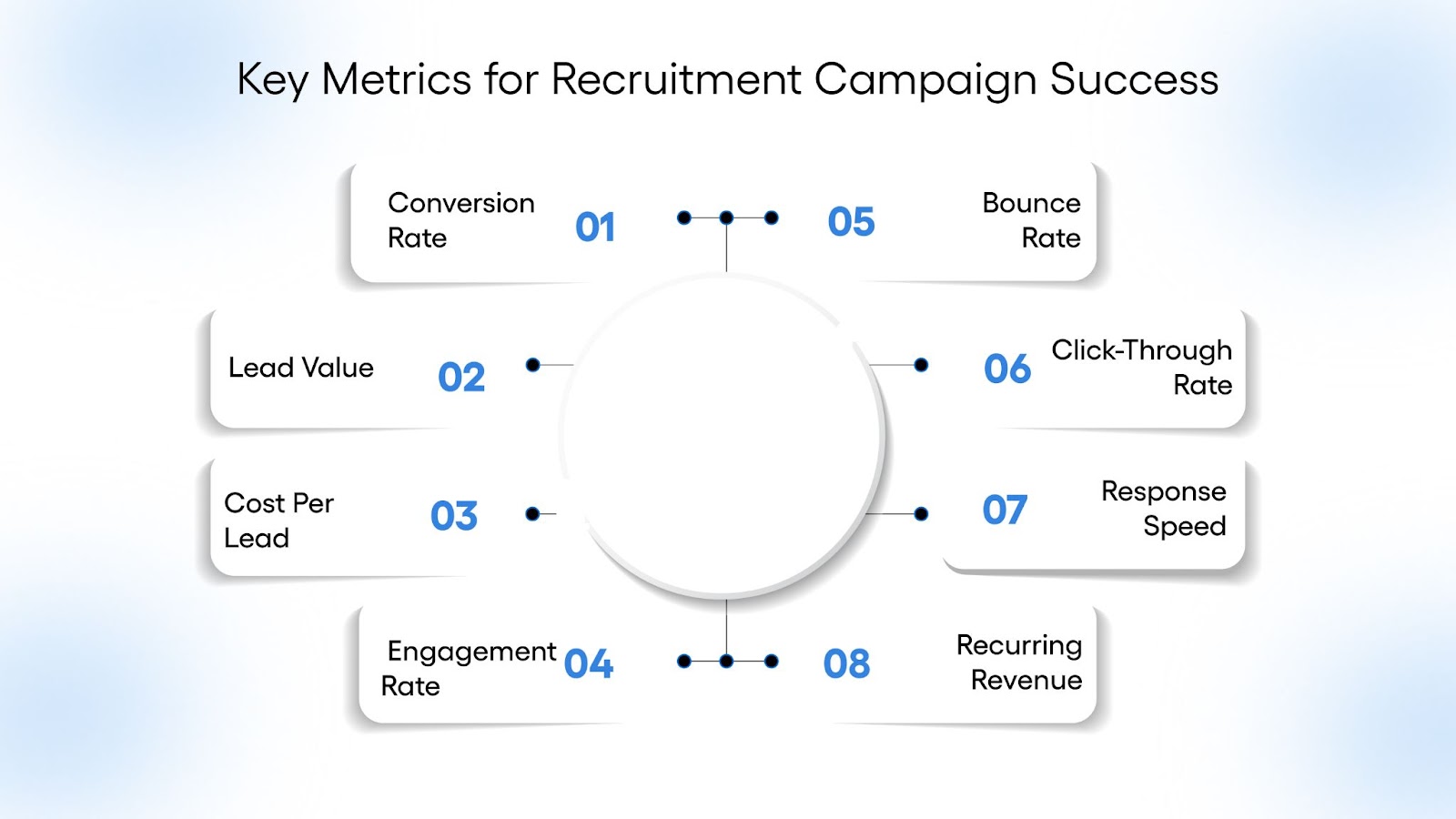
To ensure that your recruitment lead generation strategy is effective, it's crucial to measure the right metrics. Tracking key performance indicators (KPIs) helps you evaluate the success of your campaigns, identify areas for improvement, and ultimately refine your approach to achieve better results. Here are the metrics to track:
1. Conversion Rate
Conversion rate measures the percentage of leads that take the desired action, whether it’s booking an appointment or submitting an application.
Formula:
Total Number of Converted Leads ÷ Total Number of Leads × 100
Pro Tip: A low conversion rate often indicates poor lead quality or ineffective messaging. Fine-tuning your lead qualification process or improving follow-up strategies can help increase this rate.
2. Lead Value
The lead value measures the average revenue generated from each lead. It provides insight into the financial effectiveness of your lead generation efforts by directly linking leads to revenue outcomes.
Formula:
Revenue from Leads ÷ Total Number of Leads
Pro Tip: Focus on nurturing high-value leads that are more likely to convert into long-term clients, as they offer the best MRR. This helps prioritize efforts and allocate resources effectively.
3. Cost Per Lead (CPL)
CPL indicates how much you are spending to acquire a lead. This metric is particularly useful when running paid ad campaigns.
Formula:
Total Ad Spend ÷ Total Number of Leads Acquired
Pro Tip: Lower CPL is always the goal, but a higher CPL may be acceptable if it leads to higher-quality leads that convert better in the long run.
4. Engagement Rate
Engagement rate measures how actively your audience interacts with your content or emails. This is key for understanding how well your messaging resonates with potential candidates.
Formula:
Total Interactions (likes, shares, comments) ÷ Total Audience × 100
Pro Tip: If your engagement rate is low, consider experimenting with different content formats or targeting strategies to engage your audience better.
5. Bounce Rate
Bounce rate tracks the percentage of visitors who leave your website or landing page immediately without engaging or taking any action. This indicates the potential issues with content relevance or user experience.
Formula:
Single-Page Sessions ÷ Total Sessions × 100
Pro Tip: A high bounce rate often indicates that your landing page isn’t compelling enough or your traffic isn’t well-targeted. Optimizing your landing page’s content or design can help reduce this rate.
6. Click-Through Rate (CTR)
CTR is a key metric for email campaigns and paid advertising, indicating the percentage of recipients who click on your call-to-action (CTA) compared to the total number of recipients.
Formula:
Total Clicks ÷ Total Impressions × 100
Pro Tip: A low CTR suggests that your subject lines, email copy, or CTAs need improvement. Test different CTAs, subject lines, or email designs to see what resonates best with your audience.
7. Lead Response Time
This metric measures the speed at which your team responds to new leads. Fast response times can significantly improve lead conversion rates.
Formula:
Time Lead Was Received - Time Lead Was Contacted ÷ Total Number of Leads
Pro Tip: Aim to respond to leads within the first hour. Research shows that leads are 7x more likely to convert when contacted quickly.
8. Monthly Recurring Revenue (MRR)
Monthly Recurring Revenue (MRR) is a key metric for evaluating the long-term success and growth of your recruitment agency. It tracks the predictable, recurring revenue generated by clients each month, offering insights into business sustainability.
Formula:
Total Monthly Revenue from Clients ÷ Total Number of Clients
Pro Tip: MRR is a crucial metric for evaluating the sustainability and growth of your recruitment business. Regularly track this metric to ensure you’re securing consistent, long-term revenue. Focus on high-value clients to drive up MRR.
By consistently tracking these metrics, you can continuously refine your recruitment lead generation strategy and improve results. But the problem here is that it seems too overwhelming, especially when you have other things to care about.
That’s where outsourcing comes in to save the day. Let’s explore when and why you should consider outsourcing recruitment lead generation.
When and Why Should You Consider Outsourcing Recruitment Lead Generation?
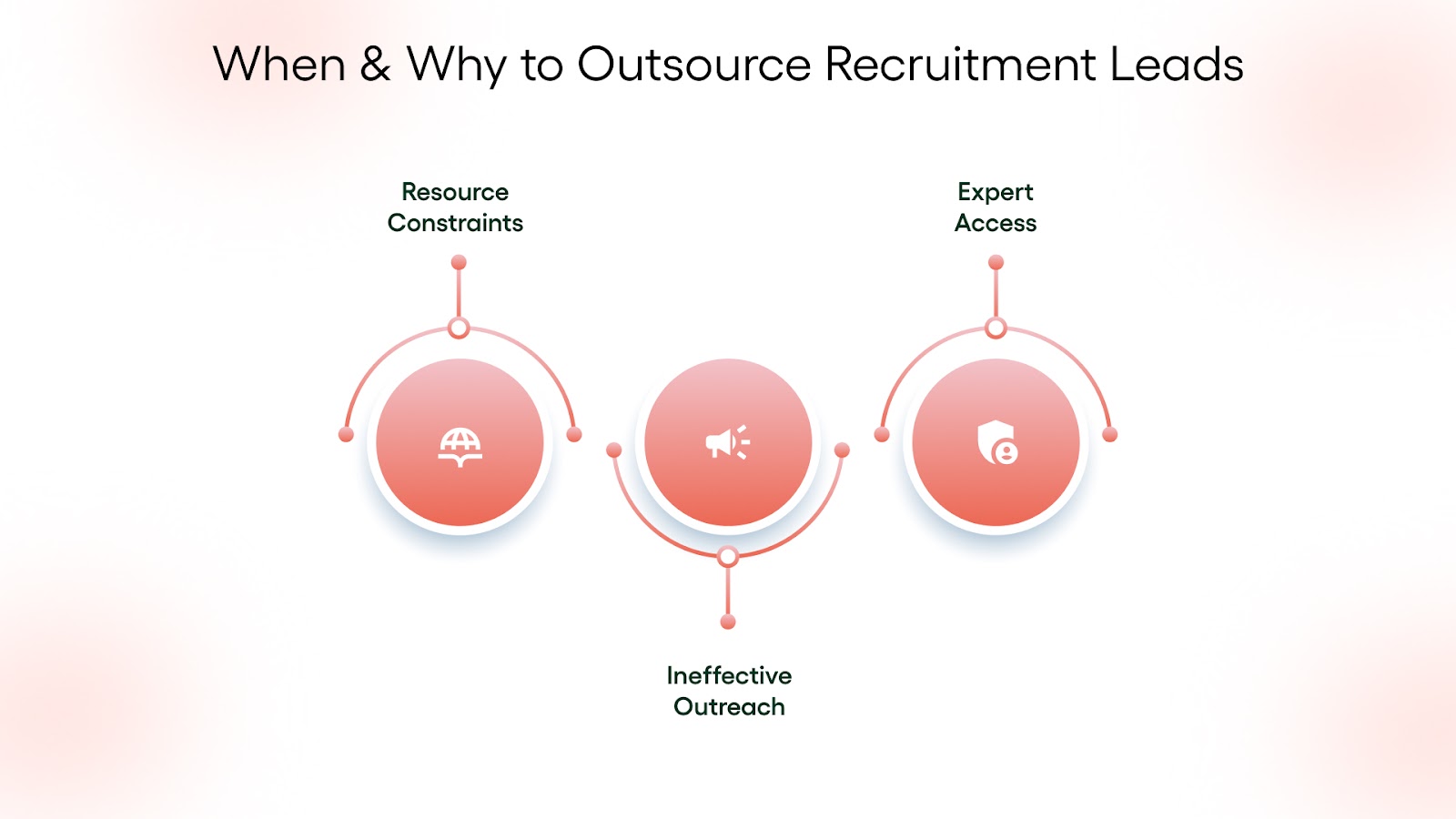
Recruitment lead generation involves many moving parts, identifying the right clients, creating the right messaging, and utilizing the best tools. Without the right strategies and resources, it can be difficult to generate consistent, high-quality leads. In those scenarios, outsourcing this entire process can be extremely beneficial.
Outsourcing your lead generation enables you to leverage specialized expertise, ensuring that your recruitment business consistently attracts the right prospects. Let’s explore when you should consider outsourcing lead generation:
- When Internal Resources Are Stretched Thin: Outsourcing recruitment lead generation is beneficial when internal resources are stretched thin, managing placements, or when a consistent and scalable lead flow is required. This allows your team to focus on core activities, such as client relationships and candidate placement, without worrying about fluctuations in lead volume.
- When Traditional Methods Aren’t Effective: If your in-house team is relying on job boards, outsourcing can bring in more targeted, data-driven approaches, saving time and increasing lead quality.
- When You Want to Tap into Specialized Expertise: B2B Lead generation providers, like The Lead Market (TLM), provide services like sales qualified leads, appointment scheduling, demand generation, targeted campaigns, and ABM, all of which help in identifying and nurturing prospects using proven methods. Their expertise allows you to stay competitive by consistently attracting the right decision-makers.
Why Should You Consider Outsourcing Lead Generation?
- Specialized Tools and Technologies: By outsourcing, you gain access to advanced lead generation tools, such as proprietary tools from TLM, that help streamline outreach and track leads effectively.
- Cost Efficiency: Outsourcing eliminates the need for in-house teams and expensive technology investments, offering a more affordable and scalable solution.
- Focus on What You Do Best: By outsourcing lead generation, you allow your team to focus on closing deals and placing candidates rather than spending valuable time on prospecting.
- Faster and Scalable Results: With dedicated lead generation efforts, you can quickly ramp up campaigns and scale efforts to meet growing demands without additional overhead.
- Expertise in Targeted Outreach: Service providers like TLM (The Lead Market) have a proven track record of utilizing customized outreach methods to engage high-value decision-makers and maintain a pipeline filled with high-quality leads.
For example, US Staffing, a client of TLM, was struggling with underperforming lead generation campaigns despite significant investments in digital marketing. They partnered with TLM (The Lead Market) to implement a targeted B2B lead generation strategy, focusing on key industries like accounting, law, IT, and financial services.
Within the first month, they generated quality leads. By months two and three, the client saw a consistent increase to six to seven leads per month, helping them outperform competitors and gain recognition in the staffing industry. TLM’s dedicated approach, including a four-touchpoint email campaign, enabled them to see results quickly and efficiently. Let’s explore how it can transform your B2B lead generation.
Achieve Consistent Lead Generation Success with The Lead Market’s (TLM) Expert Solutions
At TLM, we specialize in helping recruitment firms fill their pipelines with high-quality leads and qualified candidates. With over 9 years of experience in B2B lead generation, TLM is the ideal partner for outsourcing recruitment lead generation, delivering results-driven strategies that align with your agency's growth objectives. Our data-driven outreach, precision targeting, and focus on measurable outcomes distinguish us in driving tangible business results.
Here are some key features that make TLM the perfect choice for your recruitment lead generation needs:
- Sales-Qualified Leads (SQL): We generate highly targeted, filtered leads based on your Ideal Customer Profile (ICP), ensuring you connect with the right clients and candidates.
- Appointment Scheduling: We manage the entire scheduling process, ensuring that only confirmed meetings with relevant prospects are booked—no wasted time.
- Account-Based Marketing (ABM): Our campaigns are tailored to target high-value accounts with personalized outreach, ensuring that your messages are highly relevant to each potential client.
- Demand Generation: We employ multi-channel strategies to build brand awareness, nurture prospects, and keep leads warm, ultimately guiding them to conversion when they are ready.
- Targeted Campaigning: TLM runs campaigns focused on industries and roles that matter most to your recruitment agency, enhancing the quality of your lead pool.
- TLM Proprietary Tools: We offer real-time dashboards and customizable scripts to help streamline outreach, manage lead flow, and track performance for smarter decision-making.
- Industry-Specific Campaigning: We possess in-depth expertise in recruiting for specific industries, enabling us to craft messaging that resonates with your niche clients.
- Flexible Pricing Models: Choose from a range of flexible pricing options, including a 2-month pilot, After pilot, and enterprise packages, to fit your recruitment needs.
With TLM (The Lead Market), you're not just outsourcing lead generation; you're partnering with an experienced team that aligns with your business goals. Whether you’re looking to expand your client base or optimize your recruitment pipeline, we help you generate consistent, high-quality leads that accelerate your growth.
Book a call now, and let’s discuss how we can help you streamline your recruitment process with proven lead-generation strategies.
FAQs
1. What is lead generation in recruitment?
Lead generation in recruitment is the process of identifying and attracting potential clients or candidates who may need staffing services. It involves outreach efforts to engage decision-makers at companies looking to fill positions.
2. What are the four steps of lead generation?
- Identify your target audience.
- Engage prospects through targeted outreach.
- Nurture leads with personalized follow-ups.
- Convert qualified leads into clients or hires.
3. What does a recruitment lead do?
A recruitment lead is a potential client or candidate interested in recruitment services. For a staffing firm, a lead could be a business looking to hire or a candidate seeking new job opportunities.
4. What is the highest-paid lead generation?
High-paying lead generation often involves targeting high-value industries, such as IT, finance, and healthcare, where the demand for top-tier talent is high and recruitment services are in high demand.
5. How does TLM help with recruitment lead generation?
TLM helps recruitment agencies connect with high-quality leads through targeted email marketing, demand generation, and appointment scheduling, keeping your sales pipeline full of the right prospects.
6. How does TLM’s approach differ from traditional recruitment methods?
TLM combines data-driven strategies, personalized outreach, and proprietary tools to deliver consistent and qualified leads, eliminating the reliance on cold calls and referrals for a more efficient process.


